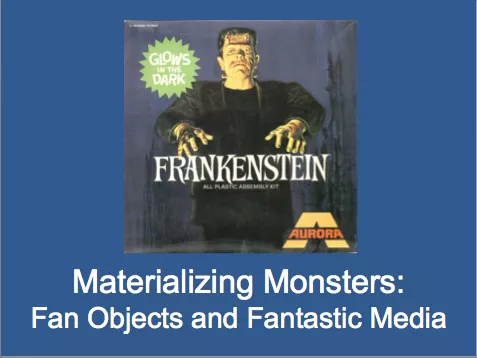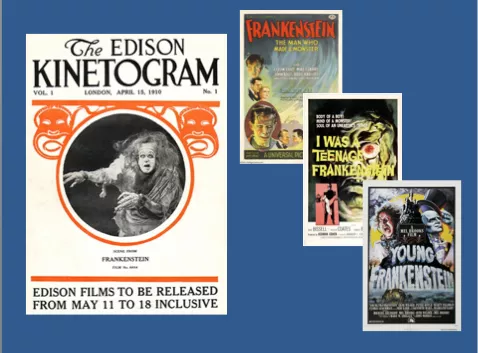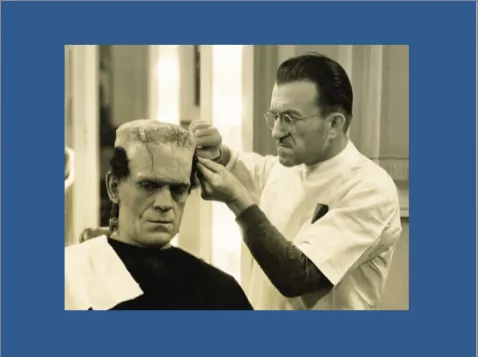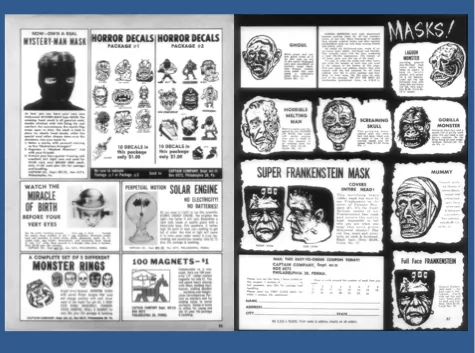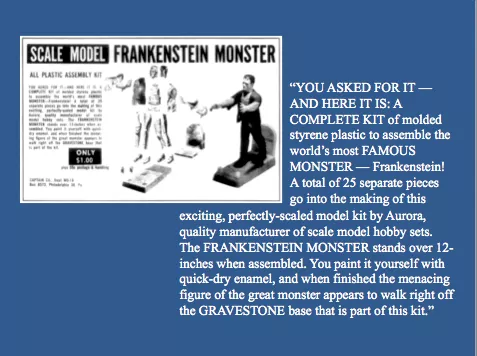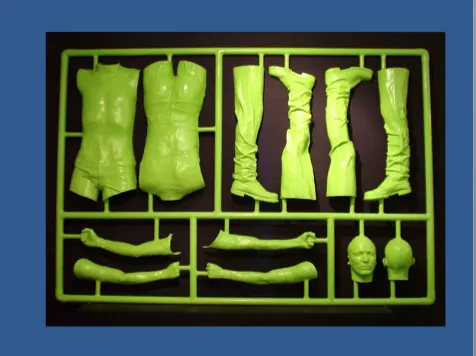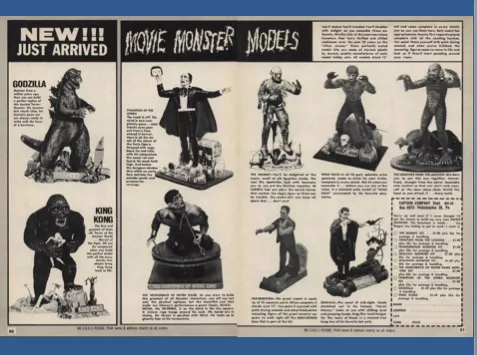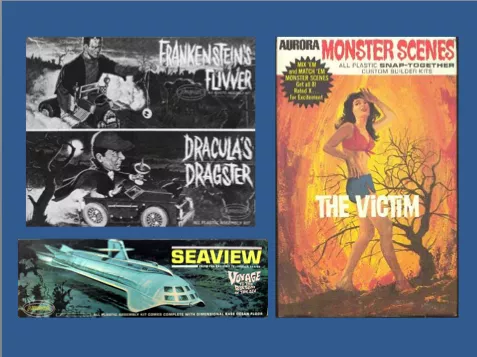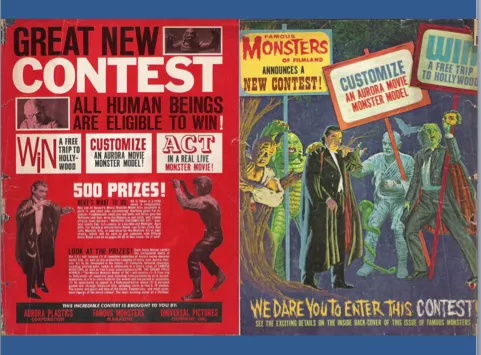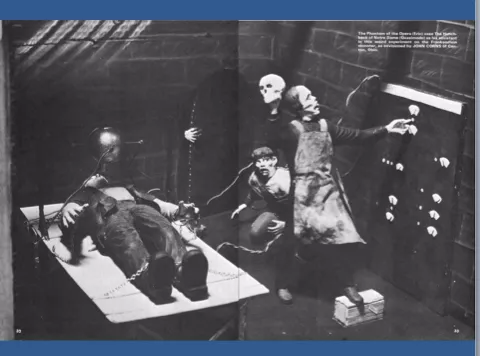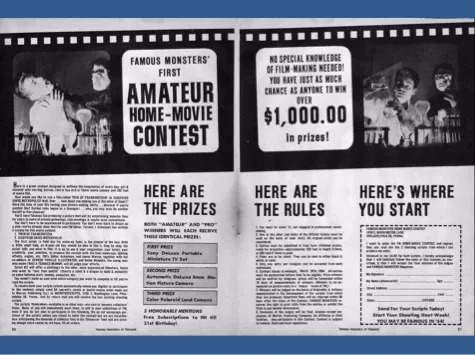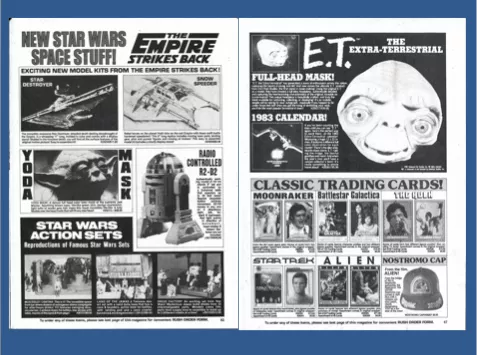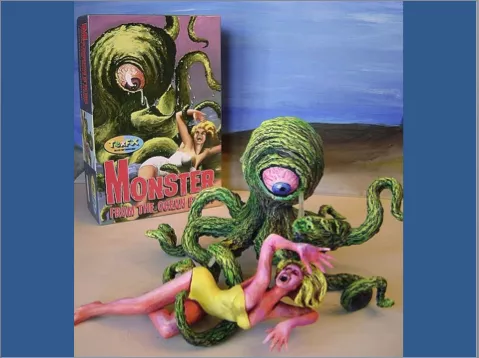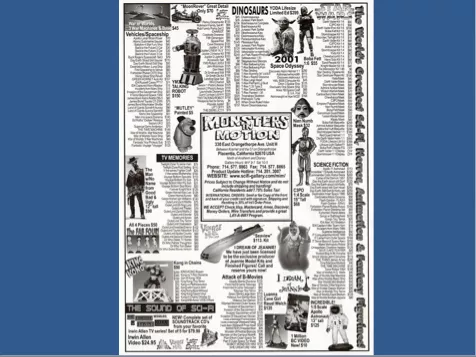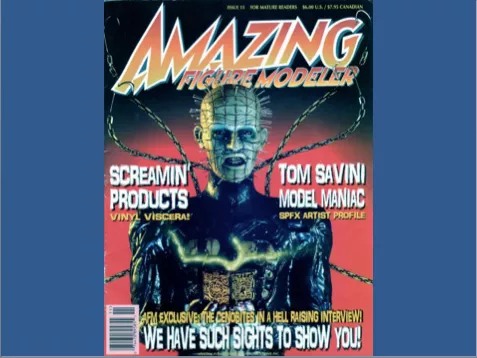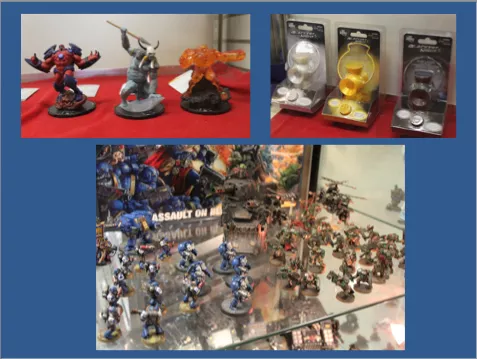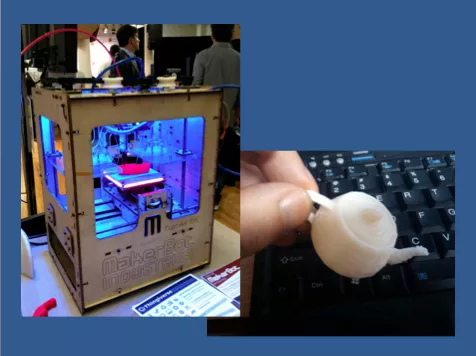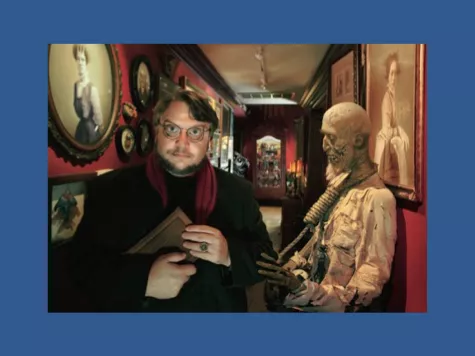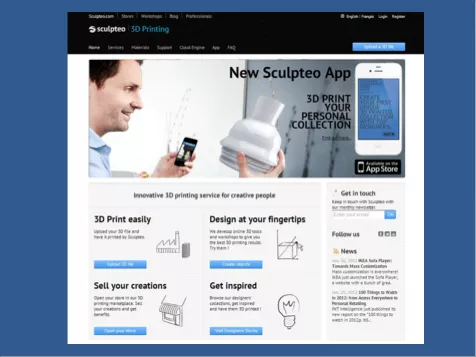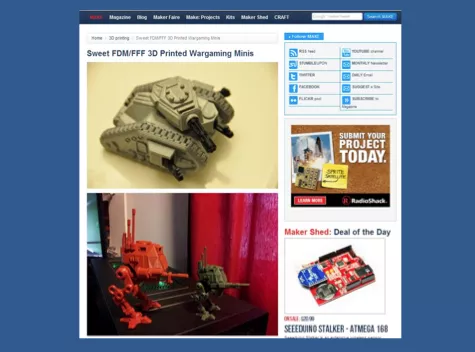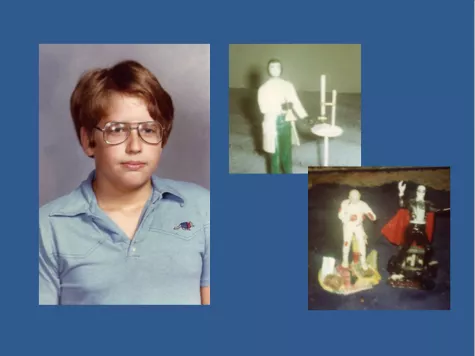Audio Transcript
Speaker 1: Welcome everyone, to the next in the series of faculty lectures. I'm delighted to see you all. Today, as you know, we're gonna be having a talk by Bob Rehak, from Film and Media Studies. His title is Materializing Monsters: Fan Objects and Fantastic Media. And he'll be introduced by his colleague in Film and Media Studies today, Patty White.
Patty White: Thank you, thank you. It's with great pleasure that I introduce my colleague in Film and Media Studies, Assistant Professor Bob Rehak. Bob's been here since 2006, and it really changed my life to have him as a near and dear colleague, my intellectual and daily life. As you know from the title and the visual illustrations, the poster but also this fabulous slide that's leaving me speechless, Bob's work is really fun. He works on all kinds of things, besides horror and sci-fi model kits, which is research from a new book project, he writes about special effects in film. So his book manuscript, More Than Meets The Eye: Special Effects in Fantastic Media Franchises, is currently under review at NYU Press, and this is a revision of his stupendous dissertation, it's really groundbreaking, for the Department of Communication and Culture at Indiana University, Bloomington, where he received his PhD.
I always like to say that this book not only takes on one of the big media franchises of the late 20th, early 21st century, but all four. Star Trek, Star Wars, Lord of the Rings, and The Matrix, if we can remember The Matrix. So I think that there's some expansiveness to his work. He's published a very important article from that project called "Migration of Forms: Bullet Time as Micro-Genre," which looks at the bullet time effect that's used in The Matrix but also in wider places in popular culture. And he's recently signed with BFI Palgrave Macmillan, with two co-editors, to publish an anthology called Special Effects: New Histories, Theories, Contexts. And again, I think that will be an important way of addressing something that is so key to contemporary film culture. And as Bob perhaps single-handedly is showing us, key to contemporary film theory.
Bob also writes about video games, and he has influential essays on fun things like retro gaming, Lara Croft, and Doom 3. He's an expert on animation. He's just published a short piece on Watchman, in a dossier on film post 9/11, so sort of thinking about how these kinds of sci-fi and thriller genres are very much affected by the war on terror. He's a beautiful writer. And he can explain technology and very complicated things like theory very clearly. For example, the technology part that I really need, lovely bibliographic essay on CGI, computer generated imagery, or just an entry on the history of the personal computer for a book on video games, that I learned so much to read. And you can experience this lovely writing voice in his blog, Graphic Engine, which he maybe can't quite post as often as he used to, because he has a very small baby, who's in the back, I hope doesn't distract you.
But it's no surprise that Bob is also a fan of these franchises and phenomenon practices that are the object of his critical intelligence and scholarly research. So he's what's now called an aca-fan, and academic fan. And in that role he's part of a rich community of scholars who take the productive activity of what used to be thought of as passive consumers very, very seriously. Indeed, Bob has helped organize a visit from Henry Jenkins, formerly of MIT and now at USC, who's probably the best known of this scholars who have taken on this important dimension of contemporary culture. He's helped organize a visit from Henry to Swarthmore, and that'll take place on February 9th and 10th, and I kind of think of that as a sequel to today, because they're in such interesting dialogue.
So clearly what Bob works on is very fun, but it's also very serious. He talks about what's consequential in our historical moment. Science and techno-culture, materiality and human labor, and the ways that our imaginings of these things have a very real impact on the lives that we lead. Since Bob arrived at Swarthmore, the resonance of this serious fun has been I think really remarkable. He teaches what I think are near legendary classes on video games, fan culture, conspiracy, and animation, in Television and New Media. He's also been instrumental in incorporating video production into our Cinema Studies curriculum, and this semester in particular, I have the pleasure of piloting our first capstone class for Film and Media Studies majors, that's trying to be more of a hybrid class, to do a little bit of production and critical studies together. And it's just been a pleasure to start out team-teaching with him.
Despite a lingering cold on Monday, which I seem now to have, Bob produced what I consider pedagogical light and magic in the classroom. Our topic was special effects, so he was on good grounds. And I'm sure he'll do something similar today, keeping the hobbyist alive in the theorist, and guiding us all to the theoretical insights that may be latent in our own hobbies. Bob?
Bob Rehak: Thank you Patty. I knew I was in for a gracious introduction, but I will also say that working with Patty everyday since I've arrived here has had a similar feeling of just wonderful welcome and support, and I can't thank you enough for that. Although maybe the gift of my cold, take that as ... And if you hear that little voice coughing in the back, that's also my cold now traveling to the next generation. Thanks also to Patricia Reilly, for all she's done to organize this, and helping with the Henry Jenkins visit, which is two weeks from today, and I won't go on plugging it except to tell you to watch your mailboxes, because we are trying to put the word out.
Of course, I want to thank the college for funding my leave year, particularly that second semester, where I was able to break the ground on the book project that I'm drawing today's talk from. And finally, I'd like to thank an absent colleague, Dr. Chris Dumas, who couldn't be here on account of living in San Francisco, but he, especially in the last week or so, was really instrumental in helping me figure out what it was I wanted to talk about today, condensing something large into something small, playing with scale, as of course model kits always do. And in case he listens to the audio version of this talk in the future, I just want to say, Future Chris, thank you.
As a new father, I have recently found myself confronting some new fears. One is that my son will grow up not liking any of the things that I like. The other is that he will like them all too much. I say this, of course, and Patty has pointed this out, I'm someone who studies new media and popular culture, with a particular interest, a really unapologetic interest, I have to say, in their more spectacular and astounding forms. Things that are fun and look good. But while I'm all for Zachary turning into a Star Trek fan, or a Star Wars fan if that's the way his flag waves, I'm less sanguine about his acquiring my taste for darker and more disturbing content. What if his favorite movie turns out to be, like mine, Alien? What if his can't miss TV series is, like mine, The Walking Dead? What if, simply by living in close proximity to my well-equipped man cave, Zach forever bears the stamp of his generative matrix, my bagged and boxed comic books, my hard SF novels, my toy spaceships, and an ever expanding collection of special effects filled movies on Blu-ray?
I worry, in short, about the role played by boy culture across the generations that connect me and my son, and about the way its pleasures have always been intertwined with the politically problematic, brushing up more than I want to admit against the consumerist, the pornographic, the bigoted, the homophobic. And anyone who has visited the image board 4chan, which is where the insurrectionist collective Anonymous makes its homeland, knows what I mean by this. Maybe it's because of these charged ideological currents in boy culture that the hybrid figure of the monster recurs like a symptom across screens and decades; its mix of delicious ugliness and haunting pathos has long been one of the lens's favored subjects. When monsters are done right, our fascination with them comes as much from identification as repulsion. Theorists of monstrosity have pointed this out many times. But their endurance as a discrete class of film iconography, indeed their proliferation throughout the mediascape, in television, video games, comics, and fantasy illustration, comes from the way they marry a certain subjective taste in looking with an appetite for making.
The word "monster" comes from a root meaning to warn or to show, compare: demonstrate. And in considering monsters as complex packages of meaning, it is worth noting another industrial dimension of their hybridity. They always mark the output of some form of labor, a congealed and localized history of design and technique in the service of realizing the unreal.
Take for example last summer's Super 8, written and directed by J.J. Abrams. It tells the story of a group of children on the brink of adolescence, four Lost Boys, one Wendy, who become involved in a government hunt for an escaped alien marauder in a small Ohio town. Its echoes of Steven Spielberg movies like E.T. and Close Encounters of the Third Kind is no accident. Spielberg produced the film, and Abrams publicly promoted it as his homage, faithful not just to the spirit of a certain late 70s, early 80s renaissance in optimism and special effects, but to the experience of being a child spectator of those movies, arguably the era's ideal viewer. Abrams, by the way, was born June 27, 1966, I learned in the course of researching this talk, making both of us 13 during the summer of 1979, in which Super 8 takes place.
Lurking within Super 8's story of a creature on the loose, a creature, it should be added, who ultimately turns out not to be so evil after all, can be found another, more modest monster. It doesn't get a speaking role. Its performance can best be described as a cameo. It is a scale plastic model of Quasimodo, the Hunchback of Notre Dame, seen here in a clip I'm about to show you, as our protagonist works on it. This is a quick clip, so watch closely.
Video Clip: [inaudible 00:11:16]
Bob: It's a small moment, a narrative lull before a spectacular storm, but significant. Notice the quick glances the camera throws across the jars of paint, establishing the tools and stages, the mise-en-scène of assembly. Building models is in fact one of the movie's motifs, culminating in a moment, spoiler alert, where the alien creature constructs his escape craft out of trash and scrap metal. But my interest in Quasimodo is less thematic than historical. For this was a real kit first sold in 1964, and its presence here ties Super 8 not just to the late 70s but to a generation prior, a subculture of boys, overwhelmingly white, middle-class, and suburban, hitting their teenage years in the late 50s and early 60s. It was Spielberg's generation, and George Lucas's, and Joe Dante's, and James Cameron's, and Robert Zemeckis's. And so forms a kind of prehistory to the blockbuster era that began in the 70s with Jaws and Star Wars, and now takes the form of vast transmedia franchises of the fantastic.
The subcultural matrix in which these boys and their toys gelled was known as monster culture, what Kevin Heffernan describes as, quote, "an explosion of horror-related media and merchandising in the mid-60s that included trading cards, LP records of old horror radio shows, 8mm home movie versions of the Universal classics, monster magazines, and reprints of 50s horror comics," unquote. In his history of horror cinema and its reception in America, David Skal underscores, bless you, the diffuse social nature of the phenomenon. Here's another somewhat long quote: "In monster culture," Skal writes, "the participatory ritual surrounding the movies were every bit as important as the films themselves. The rites included the shared witnessing of the antics of horror hosts, an explosion of fan magazines that were read, reread, and traded among the cognoscenti ..." Cognoscenti? I didn't look up how to pronounce that before this talk. It's the word you would know how to pronounce if you were a member of the group. "And even the creation of plastic model effigies. Most important," he goes on, "monsters materialized in the living room for the first time, not just reflected in the movie theaters, but now a light source. A glowing electronic fireplace around which a generation could huddle, and shudder, and share."
The glowing electric fireplace, of course, was television, the means by which horror movies came to a new audience. In 1957, Screen Gems, the syndication arm of Universal Pictures, sold its Shock Theater package of horror movies to broadcast TV affiliates and independent stations in New York, Philadelphia, and other large metropolitan markets, restoring to circulation a big catalog of films from Universal's golden age of horror, including Dracula, Frankenstein, The Mummy, The Wolfman, and their many sequels. Along with a fresh wave of science fiction and horror film production in the United States, Britain, and Japan, featuring giant creatures mutated by radiation and sinister alien invasions of home and community, the decade of the 50s was replete with monsters, from the drive-in to the rec room.
Young audiences encountered these films largely through the intermediary of a magazine, Famous Monsters of Filmland, and its editor, Forrest J Ackerman, pictured there in the corner, whose punning avuncular style mirrored the personae of local TV horror hosts, like Vampira in Los Angeles and Zacherle in Philadelphia. That's, by the way, who was in that previous slide. Akerman, himself a fan and collector, exemplified a playful but fiercely inquisitive approach to horror. His memorabilia stuffed Ackermansion was often featured in the magazine, and in combination with editorial content, heavy on behind the scenes anecdotes and profiles of special effects technicians, suggested a contiguity between insider knowledge and the ownership and display of objects. The magazine's mail order arm, Captain Company, sold products ranging from rubber face and full head monster masks to 8mm reels of abridged horror classics. And interestingly, you can also see how it was sort of threaded through with a kind of larger community of science and science toys that I associate with magazines like Boys' Life and the Boy Scouts. And it is here, in the pages of Captain Company, the advertising pages, that we again encounter the monster model. This time, at the moment of its birth.
The July 1962 issue of Famous Monsters carried an ad for a new product from Aurora Plastics Company, a scale model of Frankenstein's monster. The accompanying copy emphasized rather than elided the steps required to make it whole, and though I know the words are right in front of you, I'll read them anyway, cause I like them. "You asked for it, and here it is, a complete kit of molded styrene plastic, to assemble the world's most famous monster. Frankenstein." Purists, don't correct. You know we know. There was a doctor. "A total of 25 separate pieces go into the making of this exciting, perfectly scaled model kit by Aurora, quality manufacturer of scale model hobby sets. The Frankenstein Monster stands over 12 inches when assembled. You paint it yourself with quick-dry enamel, and when finished, the menacing figure of the great monster appears to walk right off the gravestone base that is part of this kit."
Taken with its insistent second person "you," this avowal of kit-ness suggests that the appeal of monster models stem not just from their iconic content, but the way they promise to transform readers into modelers, in a mutually reinforcing relationship of agency, much as the otherwise static plastic monster would appear to walk right off its base. And I would like to note that even the choice of subject held a neat symmetry. The monster in both the 1818 Mary Shelley novel that originated it and the 1931 film adaptation that supplied its most recognizable rendering, was pieced together from dead components, an act of Promethean assembly whose fulcrum was precisely the animate/inanimate divide.
Aurora's intersection with famous monsters came about when the company turned to horror movie characters in a quest to develop new products that would appeal to the model building community. Originally a plastics fabricator based in Long Island, Aurora spent the first part of the 50s manufacturing simple toys, such as a bow and arrow set, out of plastic. Its first model kits, like those of competitors Revell and Monogram, were of submarines, fighter planes, and sailing ships. Real world items, scaled down the miniature form and broken down into pieces for assembling and painting by the kit's buyer. In 1957, Aurora introduced a line of figure kits in the shape of people, based on the most generic of types, bride and groom, Swiss boy and girl, Apache warrior, which enjoyed only brief popularity. So searching for fresh concepts, the advertising executive Bill Silverstein was inspired by the prominence of horror on TV and in movie theaters to develop a prototype kit based on Frankenstein's monster, and went ahead and licensed the proprietary image from Universal. His coworkers were dubious about the appeal of such a kit, but when the first kit received an enthusiastic response from the children of attendees at a Chicago trade show, the monster was rushed into publication in January 1962. The first Aurora ads appeared in Famous Monsters of July of '62, and by the end of that year, two other Universal characters, Dracula and the Wolfman, had joined the lineup.
Models began as unique sculptures in wax or clay, which are then cut apart and arranged into grid-like trees on a metal die called a tooling. Once the tooling has been created, hot polystyrene plastic is flowed through its channels in a process known as injection molding, stamping out multiple identical copies. The initial stages of design, sculpting, and tooling, tend to be prolonged and expensive. Mass production of kit parts from an existing template, by contrast, rapid and cheap. This oscillation between the singular and the serial is characteristic of the figure kit's larger trajectory, through its lifespan as prototype, artifact, commodity, and final reconstruction in the hands of its owner. An Aurora monster kit crystallized, or plasticized, the individual talents of its sculptors and box cover artists, as much as the technologies of manufacture and distribution that made the model available in large numbers to a young audience of kit building fans, each of whom in turn could then fashion from identical sets of parts, a provisionally unique and personally meaningful object.
Through 1968, Aurora's monsters grew and numbered to 13, including Dr. Jekyll as Mr. Hyde, the Hunchback of Notre Dame, who we've already met, King Kong, and Godzilla. With a few exceptions, all were molded in 1/8 scale, that's where one inch of the model equals eight inches in real life, a nine inch model standing in for a six foot monster. All drew carefully on screen referents, with Universal subjects in particular traceable to the designs of the studio's key makeup artist in the 30s and 40s, Jack Pierce. Kits based on other fantastic media properties such as superheroes Superman and Batman soon joined the catalog. These were cross-advertised in an interesting kind of early synergy between DC Comics and Aurora. Similar synergies led to models based on TV series, including the Irwin Allen Productions' Voyage to the Bottom of the Sea, that's the sea view there in the bottom, Lost in Space, and Land of the Giants. These were series that often seemed to be designed actually to showcase technological objects that would lend themselves to modeling and play.
As the decade waned, Aurora sought to differentiate its monster line, reissuing older kits in glow in the dark plastic and experimenting unsuccessfully with Monstermobiles, that's up there, which crossed monsters with another fad, which was the hot rod. In 1971, one particularly prurient kit, the Victim, a half-dressed young woman in a pose of terror, drew protests from the National Organization of Women, prompting Aurora to withdraw the entire line of mix and match monster scenes to which it belonged, a moment at which boy culture perhaps came perilously close to rape culture. Yet even amid these stumbles, creature kits remained far and away Aurora's best sellers, making the company throughout the 60s and into the early 70s the world's largest hobby manufacturer. And Zach has left the room.
Monster culture emerged during a new chapter in the social history of toys and hobbies in the United States. The rise of TV as a mass medium combined with the prosperity of the American middle class and the arrival of the baby boom generation came together in the chronotope of the suburban home, populated by a nuclear family whose leisure time was structured by new categories of media-informed play. In October 1955, Walt Disney's Mickey Mouse Show premiered, the first series whose content and advertising were aimed squarely at children. Along with future toy giant Mattel, one of the show's sponsors was Hasbro, whose Mr. Potato Head epitomized the new breed of commodified, industrialized toy, made of colorful plastic, manufactured and distributed in huge quantity, marketed on TV, and intended for free, as opposed to educational, play. Unlike the toys popular with previous generations, such as wagons, Erector Sets, and Raggedy Ann dolls, toys of the 50s held a growing population of preteens as a group with interests and taste distinct from and potentially antithetical to those of their parents.
Steven M. Gelber has situated the development of kits, referring to any prepackaged set of parts requiring assembly, along a timeline of crafting and collecting that dates back to the late 19th century, when social and economic changes in the workplace led to a colonization of domestic space and time by handicrafts. For Gelber, the rising popularity of kits in the postwar era was an unfortunate development, facilitating hobbyists' productivity but curtailing their creativity. In his view, because one could only build a kit into its intended object, and because this process required nothing more than the following of pre-printed instructions, kits represented the tailorization, not just of leisure, but of imagination. The popularization of plastic kits represented, quote, "the ultimate victory of the assembly line," unquote, contrasting with an earlier era of authentic creativity in which amateur crafters, quote, "sought to preserve an appreciation for hand-craftsmanship in the face of industrialization," unquote. Gelber's thesis about the narrowing of children's imaginations by industrialized hobbies parallels contemporary critics of children's media culture in general, who see the narratives and imagery promulgated by comic strips, radio, TV, movies, and of course, nowadays, video games, as scripts dictating the proper way to play. A disciplining of useful subjectivity, whose agent is the toy based on and marketed by media.
Gelber's history of hobbies in America stops around 1950, at a pivotal shift from the kinds of kits that dominated the first half of the 20th century, miniature airplanes and boats, usually made of balsa wood, to plastic models whose referents were for the first time fictional subjects. The earliest all plastic kit, this is very interesting, to me, was in fact a kind of transmedia tie-in. In 1951, Revell had its first commercial success with a 1910 Maxwell automobile. Does that ring a bell for anybody? I didn't know if it would. Made famous by comedian Jack Benny, on his radio show and later TV show.
But if prefabricated toys of the 30s and 40s based on fantasy characters such as Superman, Dick Tracy, and Mickey Mouse, had represented the colonization of children's play by mass media, model kits introduced a new term to the equation: the opportunity for personal involvement at the level of assembly, painting, detailing, and modification by the builder. Although for Gelber, the plastic model was an imaginative dead end, its meanings and pleasures as circumscribed as its final shape, Aurora kits solidified a more subtle interdependence between media consumption and production. Monster kit builders took pieces provided by popular culture and transformed them through their labor into artifacts that were simultaneously shared and unique, constructing themselves as skilled subjects in the process of constructing their creatures.
In 1964, for example, Famous Monsters announced a competition in which readers would not just build Aurora kits but modify and submit them for judging at local hobby shops. Sorry to rush on from this slide, it's this wonderful dense aggregate of colorful signifiers, I know. In the article on winning entries that ran a yeah later, prizewinner's names accompanied photographs of their creations, plastic monsters combined with each other to make dioramas, caves, laboratories, castle dungeons, city streets, detailed with handmade props and painted backdrops. Embedded in three dimensional space, the creatures seemed to return to their cinematic roots, but their mise-en-scène is at once familiar and novel, presenting events never pictured in any movie, like this kind of strange orgy of creatures that we see there. I'm not sure what's going on, I don't want to parse it too closely.
While not precisely falling under the category of transformative works that would later come to dominate discussions of fan creativity, the model contest of '64 highlights the multivalent potential of figure modification, material mashups in which characters and settings were reconfigured into novel situations, years before slash fiction and vidding became a defining activity of Star Trek and other fandoms. In this way, the model contest merely formalized the kinds of playful creativity already rampant in Famous Monsters's pages, where photo collages, humorous captions, games, and quizzes extended to readers an implicit invitation to seize and remake monster culture according to their own amusement and interests. That this ludic sensibility profited the magazine and its brand partners, the model contest for example was jointly sponsored with Aurora and Universal, does not negate its inherently transformative spirit, or the generative potential of object play, wherein fantastic media artifacts exist not as the static endpoint of a commercial transaction, but as linkages in what we might call an object-text ecosystem, bristling networks of authorship, appropriation, and translation, whose nodes include the production of new and original content.
Along with the model contest, for example, Famous Monsters organized makeup and amateur film competitions. These reflected the magazine's early encouragement of what Anne Jerslev, writing of Peter Jackson's Lord of the Rings adaptation, labels artifact emotions toward fantastic media, in which appreciation of cinematic spectacle, here the vivid iconography of movie monsters, is paired with knowing admiration for the technical craft that went into their making. By focusing much of its editorial content on special effects, techniques, and auteurs, Famous Monsters emphasized the manufactured nature of the films it covered. With its various contests, it coaxed readers into active roles as creators. And through the materials sold by Captain Company, it provided tools to assist in that process of creation, both onscreen and off. And her what I'm referring to is the fact that much of the content in Captain Company's pages actually appeared onscreen in the form of, say, makeup kits and prop skeletons. But at the same time, Captain Company would sell cheap 8mm cameras and projectors, and in that way kind of inform the production infrastructure behind these fan films.
Perhaps most importantly in the years before playback technology such as videocassettes, DVDs, and Blu-rays became a common method for revisiting and studying cherished films, Famous Monsters and other monster culture publications of the 60s constituted an archive of still photographs and artwork, freezing for extended scrutiny the ephemeral flow of images across video and movie screens. In an instant avant la lettre of contemporary replay culture, this trove of reference material served as more than just a terminus of contemplation, inspiring and guiding the production of new horror media through a play of objects. As Michele Pierson has noted, many readers of special effects oriented fanzines of the 60s and 70s harbored hopes of becoming professional filmmakers themselves, often making their own 8mm and 16mm movies. Famous Monsters's popularity coincided with what Clive Young has characterized as a mass influx of movie cameras into postwar life, a generation of baby boomers who, as they entered adolescence, quote, "put Mom and Dad's new toy to work, fashioning their own movies that were inevitably inspired by what they were seeing at the local movie theater each weekend, monsters, spaceships, aliens, superheroes, and more," unquote. No doubt due to the seeding of DIY culture, among Famous Monsters's readerships were a number of individuals who moved on from amateur filmmaking to assume roles within the industry in the 70s and 80s, such as special effects artists Dennis Muren and David Allen.
Ackerman's final issue as editor appeared in January 1983, shortly before Famous Monsters ended its 25 year run. Ironically, the magazine folded just as the culture of fandom it had helped to instigate was becoming a mainstream phenomenon, with science fiction blockbusters of the late 70s and early 80s, in particular the nascent production empires of Lucas and Spielberg, attracting huge audiences and profits, assisted of course by a wave of tie-in toys and models. Famous Monsters's advertising pages were by then thoroughly colonized by this shift in the fortunes of fantastic media. Its cover story featured The Empire Strikes Back, and Captain Company's lineup was overwhelmingly Star Wars themed, with books, blueprints, and LP records sharing space with plastic play sets and action figures based on Lucas's movie. Although a few other film and TV properties, such as Superman, Alien, and Buck Rogers in the 25th Century, were represented among these products, most of these were of recent vintage, with little classic horror content remaining. Only the continued presence of products related to the Star Trek franchise, which had itself spawned one of the most popular science fiction kits of all time, AMT's USS Enterprise, tied Famous Monsters to its heyday.
Aurora too had fallen on hard times. Acquired by Nabisco in the early 70s, the company floundered amid a more general crisis in the U.S. hobby industry, whose factors included a decline in the number of distributors and hobby shops, the aging of the baby boomers, and the rise of digital arcade games, personal computers, and video game consoles, madly popular with children. Following losses across all areas of Aurora's line, including games and slot cars, Nabisco broke up the company in '77, selling many of its assets, toolings, reference materials, and artwork, to Monogram, then the second largest model supplier behind Revell. Over the next several years, Monogram reissued a few of the Aurora monster kits, but only to moderate success, suggesting the market had been exhausted.
If monsters themselves no longer found favor with the public, other objects based on fantastic media emphatically did. The arrival of Star Wars had ushered in a new era of product tie-ins. As Jonathan Gray argues, the voluminous paratextual entourage, I envy him for coming up with that phrase, that surrounded the franchise was not only a goldmine of merchandising, but offered audiences multiple points of entry into the fictional universe conjured by Lucas and his designers, providing fans with a means of engaging the narrative's very large cast of characters, as well as its omissions and ambiguities. Hello, Luke and Leia kissed, but they're brother and sister, what's up? And sustaining spectator interest during the intervals between new installments. Implicit in Gray's thesis about how these objects and paratexts work is the notion that blockbuster franchises following in the wake of Star Wars, such as Alien, Indiana Jones, and Transformers, rely on physical incarnation as a means of preserving their popularity and commercial viability, a kind of grout filling in the gaps that are the unavoidable structural byproduct of serial media.
From this perspective, the model of transmedia storytelling advanced by Henry Jenkins, in which a story unfolds across multiple media platforms, with each new text making a distinctive and valuable contribution to the whole, is an epiphenomenal outgrowth not just of convergence, but the ramifying ontologies of media themselves in the second half of the 20th century, when materials manufacturing made it possible to realize, in newly accurate shapes, the circulating fictions of storytelling on a massively coordinated scale.
Paratextual approaches to media franchises, however, have less to say about the kind of grassroots fabrication that began to rise just around the time of Aurora's and Famous Monsters's demise, seemingly in answer to a blockbuster landscape whose products, while varied enough in form, could find themselves to the subject matter of a handful of dominant brands. The blossoming of science fiction and fantasy media in the late 70s and early 80s had created, as it were, a cult within the cult. Audiences enjoyed endless supplies of Star Wars and Star Trek paraphernalia, but far less access to niche materials based on one shot films like Forbidden Planet and 2001: A Space Odyssey, dead TV series like The Invaders or Kolchak: The Night Stalker, and media properties originating outside the U.S. like Doctor Who and Space 1999.
To fill this need, a new class of fantastic media object emerged: the garage kit. In Japan, model makers bored with the limited range of existing kits began to create their own figures, first sculpting them in clay, then making silicone rubber molds of these sculptures and reproducing them using a number of different substances, including vinyl, PVC, resin, or epoxy, a process that's also known as cold casting. Taking their name from the isolated and aerated workspaces the messy and sometimes toxic chemistry demanded, garage kits were first produced individually and shared among close-knit fan communities. Soon, however, they evolved into small-scale businesses, with companies like Kaiyodo in 1979, Billiken in 1982, and Max Factory in 1984, selling through mail order and hobby shops kits based on kaiju, that's city destroying behemoths such as Godzilla; mecha, giant human piloted robots; Ray Harryhausen creatures; and classic movie monsters such as the Bride of Frankenstein and the Metaluna Mutant from This Island Earth. That was sort of the geek rundown, for those of you who are fans. When American fans discovered these unusual Japanese kits, they were inspired to make their own sculptures and castings and started selling them through similarly small and specialized companies such as Screamin', Halcyon, Geometric, and Dark Horse. And those came into existence roughly in a period from '87 to '90.
So. During this period, garage kits continued to evolve into the early 90s as their profitability and popularity grew, and in 1994 they hit a kind of watershed moment with the creation of two large companies that still remain to this day the place you go for such objects, McFarlane Toys and Sideshow Collectibles, that substantially expanded the variety and quantity of figures available. The same year, that's the slide, Terry J. Webb, a central player in the garage kit world, launched Amazing Figure Modeler Magazine, which consolidated the functions of a number of smaller fanzines devoted to modeling. Along with conventions devoted to toys, models, and collectibles such as WonderFest in Louisville, Kentucky, and the biannual Chiller Theatre in New Jersey, Parsippany, New Jersey, it's about two hours away, and if you go you will have great time, just saying. The figure market flared into mainstream visibility with the rise of the World Wide Web, and, in 1997, eBay, acting as accelerants.
Here is that thing I was going to show. Of course, the text is far too small to read, but you'll get a sense. My point is to emphasize the sheer variety of kits that were available. This is a 1996 ad for the California-based company Monsters In Motion, and it offers statues and sculptures in categories such as TV memories, Rod Serling from the Twilight Zone, characters from The Outer Limits, Daleks from Doctor Who, Attack of the B-Movies, Tor Johnson from Plan 9 from Outer Space, the scuba helmeted gorilla Ro-Man from Robot Monster, and vehicles and spaceships such as the Starfury fighter from Babylon 5 and the time-traveling DeLorean from Back to the Future.
This microtargeting of genre interests was driven both by the recirculation of culled archives and home rental and bootleg media, which constantly refreshed subcultural memories of specific properties, and by the connoisseurial economics of the collectibles market. Busts and figurines, for examples, are distinguished from toys and action figures principally by price and rarity. Produced in much smaller numbers than mainstream media tie-ins, figure kits can cost anywhere from $50 to $500, with most falling into a range between 100 and 200. Expense depends in part on a model's scale and consequently its size. In 1996 a one to four ratio figure of Yoda ... Sorry, Yoda. I want to say his name correctly ... sold for $63, while a one to one life-size Yoda cost almost 400. Another factor of pricing is the degree of finish desired by the buyer. An unassembled kit costs less than a complete buildup, which in turn costs less than a finished and fully painted version.
So the decades-long process by which figure kits evolved into collectibles involved the establishment of increments of displaced labor. Under the protocols of capitalism, what had once been a solitary investment of time by the home modeler could now be farmed out to the talents of a remote builder. Recalling the layered semiosis of the Aurora kits that are their spiritual and aesthetic antecedents, each garage kit or collectible figure points to an onscreen referent, carefully basing its colors and textures on film or video referents, and deriving its value from the degree to which it captures the subject's distinctive iconography. At the same time, though, each figure is imbued with attributes specific to their sculptors, from the broad gesture of a dynamic pose to a subtle detail of facial expression. Just as their cinematic and televisual referents themselves marked the compositing of creative input, the actors, the makeup artists, the costumers, the cinematographers, and so on. Figure kits condense multiple stages of artistry and technique, sedimenting within themselves the additional contributions of sculptors, painters, and manufacturers.
Recent years have seen the establishment of companies like Polar Lights and Mobius that reissue older plastic models such as Aurora's creature kits. In some cases, these kits have been produced using the original toolings. Where the toolings have been damaged or destroyed, models are sometimes reverse engineered for an injection molding, vintage kits broken apart so that their component pieces can be recast. Taken together with the phenomenon of bootlegs, which is unlicensed figures copied from existing kits and sold at lower cost, the endlessly iterated and rebirthable nature of the figure kit highlights a tension central to the fantastic media object's identity and its circulation within overlapping economies of monetary and subcultural capital, paired tendencies toward the stasis of the singular and the flow of the serial, that together render this class of artifacts especially motile across the space-time of late capitalism. In a quite literal sense, the fantastic media object is Walter Benjamin's work of art in the age of its mechanical reproducibility.
But what other objects of modernity might fit this category? Not that one. That one. Now we're traveling to Showcase Comics in Bryn Mawr. Nowadays, to visit a typical comic book store is to encounter a cornucopia of Aurora's descendants, dramatically posed monsters cast in polystyrene, resin, and vinyl; busts and figurines of superheroes and aliens; articulated action figures of robots, wrestlers, and rock stars; gaming miniatures in the shape of dragons, wizards, and sentient battle tanks. Ranked in their glass cases and deployed across battlefields, these colorful bodies form a material halo around the printed comics, graphic novels, magazines, and reference guides that are the store's ostensible reason for existence. Physical extrusions of artwork are inescapable features of a popular fantastic, crowded with comic books and graphic novels, movies and television, especially animation, and video games and tabletop games. Only recently, however, has this class of objects emerged from the marginalized category of the crude toy or the tie-in to assume a key role in transmedia storytelling and blockbuster franchises, whose coordinated networks of fictional story worlds and license merchandising seek to establish cultural ubiquity and plural revenue streams for expensively produced and technologically advanced entertainment properties.
In the sheer plenitude of its solid forms, the current mediascape can seem a bewildering ocean of stuff, especially when one considers the semiotic and ideological freight borne by these trans-substantiated fictions. Blurring the ontological distinction between screen texts and solid objects, fantastic media objects also blur dividing lines between amateurs and professionals, private and public, creativity and exploitation. From this perspective, 1960s monster culture marked the emergence in embryonic form of contemporary fantastic media, and their associated artifacts. Facilitated by Famous Monsters and shared by a subculture of baby boomers in their preteen and teenaged years, the constructive activities of 60s horror fandom laid both a generational and a physical groundwork for today's transformative, franchised, and materialized media culture.
Writing about fans of Blade Runner, Matt Hills identifies a stratum of fan creators whose desire is to replicate what's seen onscreen, to craft and build replica props. This mimetic fandom, as he calls it, operates in a different realm from other fan activities that transform or rework the text, serving instead to materialized the designed worlds of science fiction in highly skilled ways. While the types of prop creation Hills discusses date back at least as far as Star Trek, with fans in the 70s creating blueprints of ships, sets, and costumes, along with mock-ups of props like phasers and communicators, the model kits of monster culture show that the practice of materializing media fictions dates back even further, to a time when, presided over by Ackerman and Famous Monsters, the convergence of horror media and plastic hobbies encouraged baby boomers to engage with fabrication as an important tool in their fandom.
The evolving sophistication of figure kits from the early 60s to the present day suggests there is much to be learned from longitudinal considerations of object production in relation to fantastic media, how these artifacts, in Will Brooker's words, have, quote, "grown up along with their audience," unquote. Such considerations complicate overly deterministic accounts of how objects are created and sold as part of blockbuster franchise operations. The garage kit movement in particular represents a give and take with the agenda of media industries, retrieving errata of lesser known film and TV properties by incarnating them in plastic and encouraging the plastic of new installments thereby. Even as a transmedia mindset takes hold at the highest level of content providers, who seek ways to multiply their revenue streams and buttress brand identities, the community of kit builders and collectors introduces a productive noise of negotiation into market trends. At the same time, the object of practices of monster culture should not be seen as simply a phenomenon in which fan creativity mirrors professional fabrication. Rather they should remind us of the way these spears interpenetrate each other in unstable and overlapping fashion, with objects as implicated in the creation of new texts as they are in those texts' reception.
A recent New Yorker profile of Guillermo del Toro dwells on the filmmaker's memorabilia-stuffed workspace, a personal warehouse of horror, science fiction, and fantasy materials that recalls both the Ackermansion and the myriad man caves it inspired, as a monument to his, del Toro's, collector's passion, as well as a fertile workshop for new projects, including what he was then working on, a planned version of Frankenstein. Del Toro, according to the article, refines his monster designs through the dynamic interplay of illustrations and objects, sketches and sculptures, fueled by an archive of reference materials that includes the horror films beloved by the filmmaker in his youth. And now I'll quote a bit from the essay: "For someone like del Toro, giving birth to a new Frankenstein's creature is even more exciting than designing and original monster," the essay states. "Just as a renaissance painter relished the challenging of rendering the Crucifixion, a true monster maker wants to take on the icons."
From Aurora's creature kits of the 60s to the latest digital effects filled blockbuster, then, monsters have remained particularly and peculiarly buildable, populating not just the workshops and store shelves of fandom, but the ways in which horror media themselves are reimagined, rebooted, and relaunched in new forms. As these references to renaissance imagery suggest, the period I have been sketching out arises from a much larger set of antecedents and has its own much deeper history. The fantastic media object resembles other venerated and iconographically charged artifacts throughout time, such as the religious reliquary, or monstrance ... I've always liked that term. They're not the same thing, reliquaries and monstrances, but they do something similar ... as well as a long lineage of toys and playthings invested with nostalgic value, or what Susan Stewart in her book on longing refers to as the miniature, the souvenir, the collection.
Although the cultural lifespan of monstrous objects such as the creature kit is clearly informed by nostalgia, for the purposes of this study, I have chosen to engage with them from a different angle, just as I have avoided framing them in the term suggested by, for example, Bill Brown's thing theory, or the anthropological study of material culture. This is certainly not meant to disparage those lines of inquiry, but to focus on a recent evolutionary trend in the way such objects have come to be designed, produced, and circulated.
In particular, I have tried to highlight a transition that occurred in the United States following the end of World War II, when the content of an older medium, film, and a newer one, television, converged with a new mode of mass production, the plastics industry. As Susan Freinkel documents in Plastic: A Toxic Love Story, the dawn of the Plastic Age dates back to 1941, when the American military began substituting plastics as a necessity to replace aluminum, brass, and other metals that were in short supply. It was during this period that the plastics we know today, such as nylon, acrylic, styrofoam, and polyethylene, were introduced on a much broader scale. Following the end of the war, Freinkel writes, the ramped up industry, quote, I like this, "had to turn its synthetic swords into plastic plowshares," unquote. And with the addition of one other social ingredient, the baby boom, the conditions for an epochal shift in the nature of entertainment media were set.
Plastics or polymers, meaning very long chains of atoms or small molecules bound into repeating patterns, these self-similar linkages are extremely versatile in structure and layout, so that with what Freinkel calls a little chemical nudging, they can be built up into forms that are thick or thin, rigid or soft, transparent or opaque. Earlier I noted an analogy between the literary conception of Frankenstein's Monster and the model kit from which its solid form can be assembled. A similar symmetry can be seen in the relationship between plastics manufacture and the serialized spread of media brands, both of which depend on the passage of protean substance through a stamping mechanism that gives its specific shape an identity, just as the premise of an ongoing TV series, line of movie sequels, or a video game franchise allows for theoretically infinite expansion under the template of an established story world populated with distinctive characters, locations, and items. With their existential root in the fictional, and the detailed indexical weight they accord the wholly invented, fantastic media objects mark the intersection of two distinct ontologies of media, the fleeting software of storytelling and the enduring solidity of the object.
Call it build code, this set of fantasy designs that, through their marrying of program to product, belong to a class of generative textual forms, such as digital files and video game engines, but more prosaically blueprints, sketches, and screenplays, interstitial and enabling scripts, that either directly generate or serve as guiding templates for the materialization of fictional worlds. These alternate reality description languages and their mechanical counterparts are only now coming into focus as the animating spirit behind rapid prototyping and desktop fabrication technologies. I think I have to move backwards ... Yes, pardon me.
So-called 3D printers, such as the MakerBot pictured here, it's price point has just dropped to under $2000 if you want the one that can print in two colors of plastic, take digital files and turn them into material objects using plastic, metal, and paper, as their ink. Initially expensive and limited to industrial usage, 3D printers are becoming cheaper and more user-friendly, to the point where they might soon become standard consumer objects you would find at Best Buy, devices that sit on our desktop, ready to output data in solid form. Their rapidly descending price point, along with the introduction of easy to use capture tools like the iPod app Sculpteo, which will not actually print your object but will allow you to create a quick 3D capture of it and then send it somewhere for printing ... You can see this person has just made a vase out of somebody's face, perhaps his own ... suggest that we are not far away from a time when the copying, sharing, and modification of objects will become as commonplace as the copying, sharing, and modification of texts.
I suspect it will be at that point when the full impact of fantasy build code will become apparent, as fans use 3D printers to generate not just singular creations of their own design or replacement parts from the Ikea catalog, but objects that merge the mass and the personal in more complex ways. I say that, by the way, as someone who's always losing that little tool that you put things together with, so, alright. Objects that merge the mass and the personal in more complex ways, branded and licensed objects with their highly engineered to-be-looked-at-ness. The terrain this will open up promises to be one in which copyright and intellectual property are aggressively debated and rethought, as evidenced by last week's announcement that The Pirate Bay, one of the more notorious online clearinghouses of torrented material, has created a new category, the Physible, to share the CAD/CAM files from which 3D objects, such as these miniature figures for use in tabletop wargaming, can be downloaded and printed.
But if build code shares more that just its initials with boy culture, then we may be back where we started, in terms of reckoning with the replication of the old within the new, the reproduction of hegemonic pleasure and privilege and corollary dynamics of exclusion, containment, and othering, within the twin seductions of the state of the art and the subjectively significant. And of course, if you haven't figure it out, you're looking at me when I was about 13. Those were the model kits that I built and felt the need to photograph. So there you are, with the object-text ecosystem. I've proved it.
The mutually determining texts and objects of fantastic media with which I grew up are likely to be all the more pervasive and hard to escape for my son. So as both a new parent and a media scholar, I work in the hope that my field stands ready to recuperate an older sense of medium, as not just communication channel, but material practice; that it is prepared to confront the increasingly blurred and inextricable relationship between ephemeralities of the screen and objects of the home workshop, the store, and the convention; that it can address the industrialized imaginary in all of its touchable, buildable, and ownable forms. Thank you.
